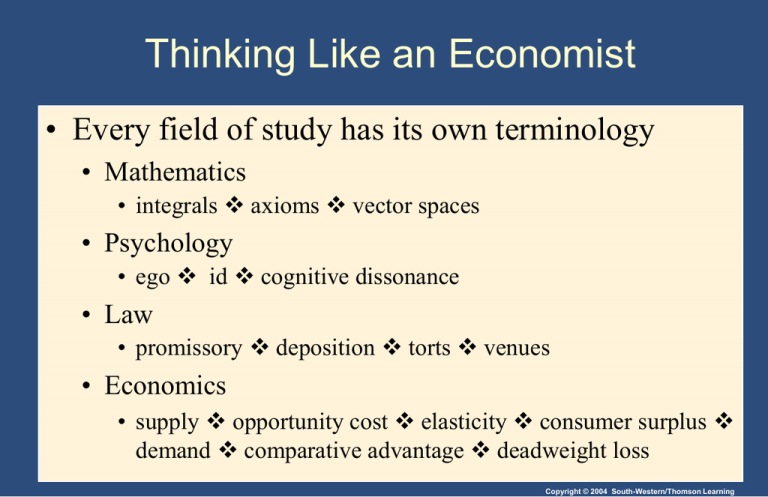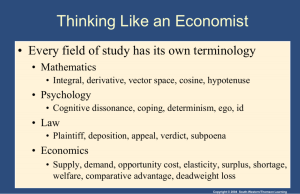production possibilities frontier
advertisement

Thinking Like an Economist • Every field of study has its own terminology • Mathematics • integrals axioms vector spaces • Psychology • ego id cognitive dissonance • Law • promissory deposition torts venues • Economics • supply opportunity cost elasticity consumer surplus demand comparative advantage deadweight loss Copyright © 2004 South-Western/Thomson Learning Thinking Like an Economist • Economics trains you to. . . . • Think in terms of alternatives. • Evaluate the cost of individual and social choices. • Examine and understand how certain events and issues are related. Copyright © 2004 South-Western/Thomson Learning The Scientific Method: Observation, Theory, and More Observation • Uses abstract models to help explain how a complex, real world operates. • Develops theories, collects, and analyzes data to evaluate the theories. • Economists make assumptions in order to make the world easier to understand. Copyright © 2004 South-Western/Thomson Learning Economic Models • Economists use models to simplify reality in order to improve our understanding of the world • Two of the most basic economic models include: • The Circular Flow Diagram • The Production Possibilities Frontier Copyright © 2004 South-Western/Thomson Learning Our First Model: The Circular-Flow Diagram • The circular-flow diagram is a visual model of the economy that shows how dollars flow through markets among households and firms. • Factors of Production • Inputs used to produce goods and services • Land, labor, capital and entrepreneurship Copyright © 2004 South-Western/Thomson Learning Figure 1 The Circular Flow Revenue Goods and services sold MARKETS FOR GOODS AND SERVICES •Firms sell •Households buy Wages, rent, and profit Goods and services bought HOUSEHOLDS •Buy and consume goods and services •Own and sell factors of production FIRMS •Produce and sell goods and services •Hire and use factors of production Factors of production Spending MARKETS FOR FACTORS OF PRODUCTION •Households sell •Firms buy Labor, land, and capital Income = Flow of inputs and outputs = Flow of dollars Copyright © 2004 South-Western Our First Model: The Circular-Flow Diagram • Firms • Produce and sell goods and services • Hire and use factors of production • Households • Buy and consume goods and services • Own and sell factors of production Copyright © 2004 South-Western/Thomson Learning Our Second Model: The Production Possibilities Frontier • The production possibilities frontier is a graph that shows the combinations of output that the economy can possibly produce given the available factors of production and the available production technology. Copyright © 2004 South-Western/Thomson Learning Figure 2 The Production Possibilities Frontier Quantity of Computers Produced 3,000 D C 2,200 2,000 A Production possibilities frontier B 1,000 0 300 600 700 1,000 Quantity of Cars Produced Copyright©2003 Southwestern/Thomson Learning Our Second Model: The Production Possibilities Frontier • Concepts Illustrated by the Production Possibilities Frontier • • • • • Scarcity Efficiency Tradeoffs Opportunity Cost Economic Growth Copyright © 2004 South-Western/Thomson Learning Microeconomics and Macroeconomics • Microeconomics focuses on the individual parts of the economy. • How households and firms make decisions and how they interact in specific markets • Macroeconomics looks at the economy as a whole. • Economy-wide phenomena, including inflation, unemployment, and economic growth Copyright © 2004 South-Western/Thomson Learning THE ECONOMIST AS POLICY ADVISOR • When economists are trying to explain the world, they are scientists. • Positive statements attempt to describe the world as it is, descriptive analysis. • When economists are trying to change the world, they are policy advisor. • Normative statements attempt to describe how the world should be, prescriptive analysis. Copyright © 2004 South-Western/Thomson Learning POSITIVE VERSUS NORMATIVE ANALYSIS • Positive or Normative Economics? ? • An increase in the minimum wage will cause a decrease in employment among low-skilled workers. • The government should not raise the minimum wage. ? Copyright © 2004 South-Western/Thomson Learning POSITIVE VERSUS NORMATIVE ANALYSIS • Positive or Normative Economics? ? • Higher federal budget deficits will cause interest rates to increase. • The government should be forced to run a balanced budget. ? Copyright © 2004 South-Western/Thomson Learning WHY ECONOMISTS DISAGREE • They may disagree about the validity of alternative positive theories about how the world works. • They may have different values and, therefore, different normative views about what policy should try to accomplish. Copyright © 2004 South-Western/Thomson Learning Summary • Economists try to address their subjects with a scientist’s objectivity. • They make appropriate assumptions and build simplified models in order to understand the world around them. • Two simple economic models are the circular-flow diagram and the production possibilities frontier. Copyright © 2004 South-Western/Thomson Learning Summary • Economics is divided into two subfields: • Microeconomists study decisionmaking by households and firms in the marketplace. • Macroeconomists study the forces and trends that affect the economy as a whole Copyright © 2004 South-Western/Thomson Learning Summary • A positive statement is an assertion about how the world is. • A normative statement is an assertion about how the world ought to be. • When economists make normative statements, they are acting more as policy advisors than scientists. Copyright © 2004 South-Western/Thomson Learning






